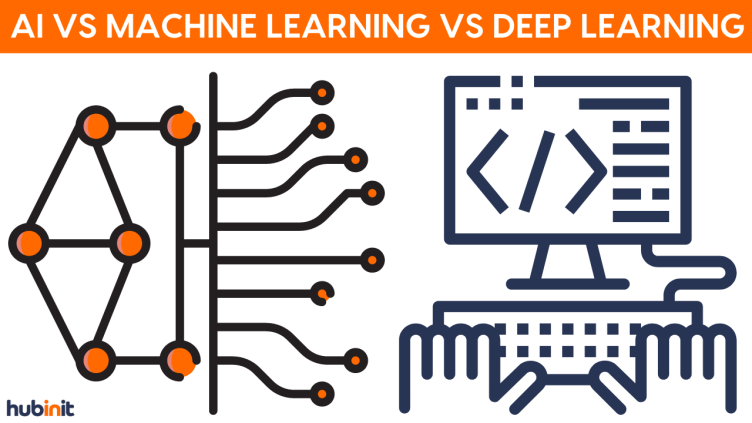AI vs Machine Learning vs Deep Learning


Tyler Hill
April 8th 2023
Deep Learning, Machine Learning, and Artificial Intelligence are the most often used phrases for IT professionals on the internet. Yet, all three technologies are linked to one another. Artificial intelligence (AI) is a broad term that encompasses both machine learning and deep learning. Deep learning and machine learning are both subcategories of artificial intelligence.
In general, Artificial Intelligence (AI) refers to when a computer duplicates cognitive capabilities that people identify with other human brains, such as learning and problem-solving. On a more basic level, AI can simply be a programmed rule that instructs the machine to respond in a certain manner under certain scenarios. To put it in another way, artificial intelligence can be nothing more than a series of if-else assertions.
AI may be broadly classified into four types:
1. Machine that reacts
2. Restricted memory
3. Mind Theory
4. Consciousness
Artificial intelligence applications include:
- AI in healthcare
- Voice recognition, text recognition, and picture recognition
- AI in gaming
- AI in cybersecurity
- AI in social media
- AI in robotics
- AI in entertainment, agriculture, E-commerce, education, and so on
Machine Learning is a set of algorithms that evaluate data, learn from it, and make intelligent decisions according to the knowledge gained. Machine learning may result in a wide range of automated jobs. It has an impact on almost every area, from IT security malware detection to weather prediction to stockbrokers seeking the best deals. To accomplish the required functionality and outcomes, machine learning necessitates complicated arithmetic and a large amount of coding. Machine learning integrates traditional methods for a range of functions such as grouping, modeling, and classification. These algorithms must be trained on massive volumes of data. The more data you feed your algorithms, the superior your models become.
Types of Machine Learning:
Machine Learning is classified into four categories based on the methodologies and strategies used to instruct machines:
1. Supervised Machine Learning
This sort of ML approach trains systems with labeled datasets, and the machines estimate the results depending on these sets of data. It requires supervision to build models and forecast outcomes. Some of the most significant applications of supervised machine learning include image segmentation, medical diagnosis, fraud detection, spam detection, speech recognition, and so on. Supervised machine learning may be divided into two problems: classification & regression.
2. Machine Learning Without Supervision
Unsupervised machine learning is the polar opposite of supervised machine learning. The technique does not require supervision, unlike supervised machine learning, and so does not need marked datasets to train computers. As a result, the outcome of unsupervised machine learning is projected. The unsupervised learning algorithm’s main goal is to classify or group unordered information based on similarities, patterns, and differences. Unsupervised machine learning has several applications, including network analysis, recommendation engines, anomaly detection, singular value decompositions, and so on. Unsupervised machine learning is divided into two types: clustering & association.
3. Semi-supervised Machine learning
Semi-supervised learning combines supervised and unsupervised machine learning. Although it trains algorithms and predicts output using both labeled and unlabeled datasets, it typically employs unlabeled datasets.
4. Learning through Reinforcement
Reinforcement learning is described as a commentary strategy for learning from previous experiences and improving the quality of the model. An AI agent autonomously examines its surroundings using striking and test actions in this manner. Moreover, computers in algorithms that use reinforcement learning acquire knowledge based on experience or previous data rather than labeled data. It may be used in a variety of real-world applications such as video games, resource management, robotics, text mining, operations and research, and so on. Reinforcement learning is divided into two types: positive reinforcement learning & negative reinforcement learning.
There are 7 simple steps involved in machine learning:
- Data collection
- Data pre-processing
- Choose model
- Train model
- Evaluation model
- Tune model
- Prognosis
Deep Learning is a relatively new artificial intelligence topic based on artificial neural networks. Because deep learning algorithms require data to learn and find solutions, it’s classified as a subsection of machine learning. The words machine learning and deep learning are sometimes used interchangeably. These algorithms, however, have distinct capacities. Deep learning employs the neural network, a multi-layered structure of algorithms. Deep learning models can tackle challenges that machine learning models cannot. This is due to the unique characteristics of artificial neural networks.
Deep learning is responsible for all recent improvements in IQ. We wouldn’t have developed self-driving vehicles, chatbots, or voice assistants like Alexa and Siri without deep learning. Google Translate would remain crude, and Netflix wouldn’t have any notion of what movies or TV shows to recommend.
Deep learning proceeds in a series of basic steps.
- Determine the weighted sum.
- Use the scaled total as a response for the input signal.
- The activation function adds bias and determines the degree to which the neuron should be stimulated.
- In the output layer, predict the output.
- Compare projected and actual output and utilize the backpropagation approach to improve the model’s performance. At this phase, the cost function is critical in lowering the error rate. Types of deep neural networks.
There are some different types of deep learning networks available:
- Feed-forward neural network
- Radial basis function neural networks
- Multi-layer perceptron
- Convolution neural network (CNN)
- Recurrent neural network
- Modular neural network
- Sequence-to-sequence models
Deep Learning Applications:
- Fraud detection
- Natural language processing
- Virtual personal assistance
- Text, speech, and image recognition
- Automatic game playing
- Auto handwriting generation
- Automatic language translation
